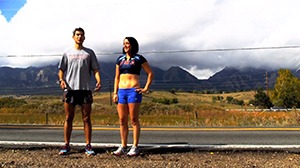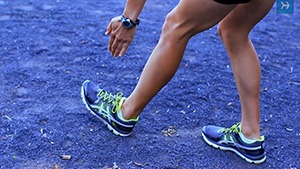Jogging is something i’ve taken a shinning to. Yes I know I said shinning, that’s because through lack of proper preparation I came close to shin splints. Not fun. Because of this I’ve tried to learn some good techniques for jogging as well as some ways to get better as a runner. Here are the tips I’ve compiled.
[highlight color=”yellow”](1) Listen to something[/highlight]. This may seem pretty obvious but listening to something music, podcast or audiobook keeps your mind stimulated. When your mind is stimulated your not focused on jogging and you get into a natural rhythm. I’ve found it helps my jogs go by with fewer brakes. [highlight color=”yellow”](2) Set reasonable goals[/highlight]. Did you just start jogging? Don’t try to run a 5k. Start slow and ease into a routine. When I first started jogging I did what I like to call “wogging” a mixture of walking and jogging for 1/2 around the perimeter of my complex. I slowly graduated to jogging 1/2 mile and worked my way up in distance and speed. Another goal I like to set for myself was when to take a break from jogging and walk. When you’re not in shape and you start walking after jogging a decent amount your mind and body want to keep walking. If you’re goal is to progress as a runner walking your entire route will not help that. What I do is pick an object ahead of me perhaps a street corner, a tree, a mailbox and say once I reach that I start jogging again. This gives me time to rest, prepare and gives me a definite time to start going again. I’ve found this to be a huge psychological help. [highlight color=”yellow”](3) Sync your steps to beats[/highlight]. If you’re the kind to listen to music rather than podcasts you can gain stamina through BPM (beats per minute). The basic idea is that by syncing your steps with the beats of a song that’s say 135 beats per minute in an hour you will have run approximately 5.22 miles. I have found this to be a good way to train. Here are two ways this can work: [tabgroup] [tab title=”Weekly / Bi-Weekly Workout”]You can use one playlist for a specific BPM range weekly or bi-weekly. As you get comfortable at each pace you can switch to the next BPM up. If you are dilligent you will up your speed and stamina over a period of time.
12:00 minutes/mile = 05.00 mph = 130 bpm
11:30 minutes/mile = 05.22 mph = 135 bpm
11:00 minutes/mile = 05.45 mph = 140 bpm
10:30 minutes/mile = 05.71 mph = 145 bpm
10:00 minutes/mile = 06.00 mph = 150 bpm
09:30 minutes/mile = 06.32 mph = 155 bpm
09:00 minutes/mile = 06.67 mph = 160 bpm
08:30 minutes/mile = 07.06 mph = 165 bpm
08:00 minutes/mile = 07.50 mph = 170 bpm
07:30 minutes/mile = 08.00 mph = 175 bpm
You can greate a playlist with multiple speeds that take you throughout an entire cardio workout (See examples below).
Song 1: 05.71 mph = 145 bpm (WarmUp)
Song 2: 06.00 mph = 150 bpm (Easy Pace)
Song 3: 06.32 mph = 155 bpm (Speed Pace)
Song 4: 06.00 mph = 150 bpm (Easy Pace)
Song 5: 06.32 mph = 155 bpm (Speed Pace)
Song 6: 06.00 mph = 150 bpm (Easy Pace)
Song 7: 06.32 mph = 155 bpm (Speed Pace)
Song 8: 06.00 mph = 150 bpm (Easy Pace)
Song 9: 06.32 mph = 155 bpm (Speed Pace)
Song 10: 05.71 mph = 145 bpm (Cool Down)
If you’re interested in figuring out exactly how to convert bpm to mph conversion for your stride specifically check out these two articles: eHow, Live Strong and Nova. If you’re okay with generalities here are some conversions I found. If this sounds good to you but you don’t know where to start in finding music that is the right BPM here are a couple resources. (1) If you’re a Spotify junky like me I would suggest searching various BPM’s in the search bar and subscribing to the playlists. (2) Jog.FM is another good resource. (3) Finally, you can check out DJBPMStudio.com and search for your albums and mark down the bpms and create your own playlists.
[highlight color=”yellow”](4) Get App Assistance.[/highlight] If you have a smart phone there are all sorts of apps to help you out community apps like Fitocracy (iOs, Android) that pit your fitness endeavors against others, GPS tracking apps like Runtastic Pro (iOs, Android) or Runmeter or C25K which stands for Couch to 5K (iOs, Android). The only roadblock is you. These apps all have free versions and help you track your overall fitness from week to week. [highlight color=”yellow”](5) Get Proper Form & Equipment[/highlight]. The fact that I did not have proper form or decent running shoes was a major contributing factor to hurting myself. Avoid that, if you’re really want to get into jogging do some research drop a little money and do it right. Below are two videos that go over good form.One thing I found while looking into this is there are many schools of thought on running. Find the one that works best for you.
There are several factors to deciding what kind of shoe you need to buy. Check out the link here and go through Step 1,2 & 3 to get a better idea. I like my Aasics but they may not be the best for you. Check out reviews, look on Amazon, seek out some deals.
[highlight color=”yellow”](6) Get to Stretchin[/highlight]. This is another area I failed. make sure to stretch before and after you jog. A simple 5 minute stretch is better than no stretch at all and can save on soreness later. Though 15 minutes would probably be more advisable [highlight color=”yellow”](7) Breathing is a good thing[/highlight]. I’m not a pro at breathing yet, but I know breathing is important. I found a good article that goes over several different jogging breathing techniques including: Mouth Breathing, Belly Breathing, Breathing to Music and Breathing to Steps. As I jogged today I noticed myself leaning more on the side of breathing to steps. Check out the info at this LINK and try them out.Well that’s all I’ve learned so far. Hope it’s useful to someone.
Bryce



